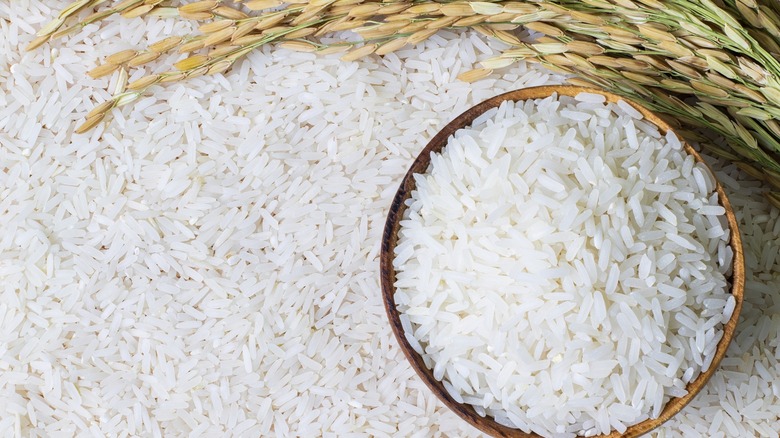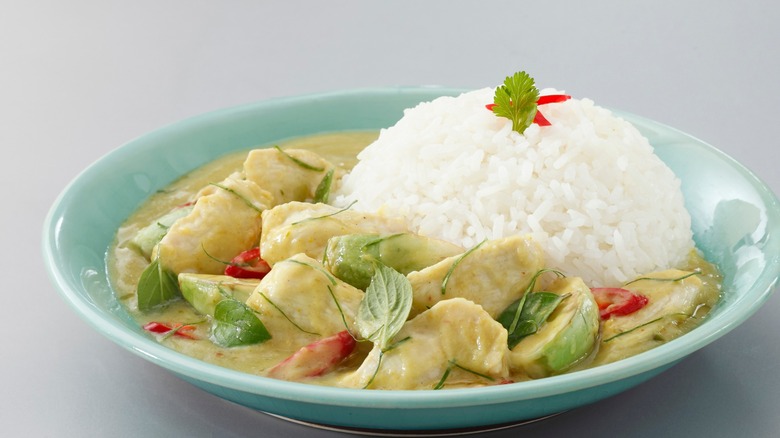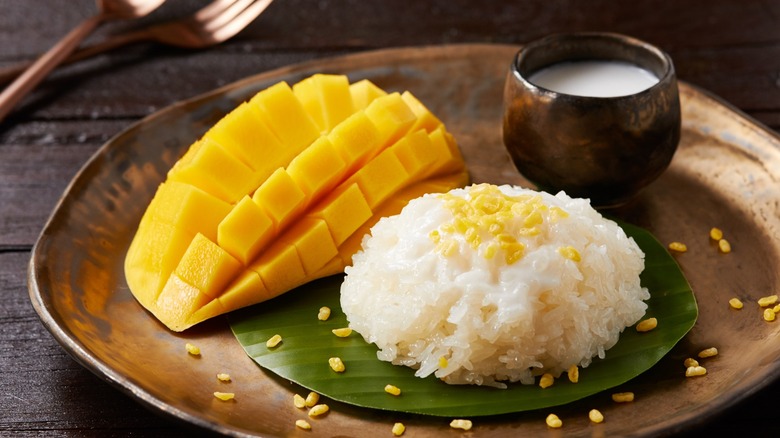The 2 Types Of Rice You'll Find In Nearly Every Thai Meal
Thailand is a major rice exporter worldwide, so it shouldn't be surprising that rice is at the heart of its culture and food. Aside from noodle plates, rice is an integral element in most Thai cuisine from curries and stir fry to larb salad and soups such as Kao Tom Goong (a breakfast rice soup). But none of these recipes call for plain old rice. Rather, there are two specific types — Thai jasmine rice and sticky rice — that are found in nearly every Thai meal, lending a distinct and essential quality to whatever dish they enhance.
As Los Angeles-based chef/owner of Chao Krung Thai, Amanda Maneesilasan, explained to Food Network, "Thai people consume rice every day, maybe even three times a day." In fact, rice is so ubiquitous in Thailand and so synonymous with mealtime that the greeting, "gin khao yung," roughly translates to, "Have you had rice yet?"
Whether you're planning a night out to your favorite Thai restaurant, or learning to cook your favorite Thai dishes at home, having a working knowledge of these two kinds of rice, and what sets them apart, can help you better understand the vibrant art of Thai cooking.
Thai jasmine rice
Thai jasmine rice (Hom Mali), the most commonly eaten rice in Thailand, is a long-grain rice known for its nutty flavor and pleasant scent. The origins of the name jasmine have often been misattributed to its smell, but jasmine rice looks more like jasmine flowers' individual petals than it smells like the flower. To some, jasmine rice smells more like freshly buttered popcorn. As Maneesilasan notes, "For people from Thailand, it smells like pandan." A tropical plant (also called screw pine), pandan has a floral, grassy, vanilla-like scent and flavor.
Excellent for savory dishes like fried rice, you'll often see jasmine used in Thai dishes as an accompaniment to curries and grilled meats, and to sop up all those tangy chili-spiked sauces. It's lovely when cooked in coconut milk for slightly sweet coconut rice that plays nicely with Thai curries, as well as with Indian and Caribbean fare. When cooked properly, jasmine's thin, long chewy texture helps it maintain its individual grains, instead of clumping together into soggy mush.
When cooked on the stovetop, jasmine rice uses a 1.5:1 ratio of water to rice. To cook, simply add 1 cup of pre-rinsed jasmine rice to 1.5 cups of boiling water, stir, cover, and simmer until all of the water has been absorbed (about 15 minutes).
Sticky rice
Sticky rice (Khao Neow) is different from jasmine rice in that it is glutinous, making it both shorter in grain, higher in starch, and more opaquely white than other types. It gets its name from its intrinsic stickiness, making it perfectly suited to eat by hand.
Sticky rice works best in Thai dishes that are mildly sweet and deliciously sticky. It's ideal for lightly sweet desserts like classic Thai mango sticky rice, where luxurious coconut milk-soaked rice meets the sultry, honey-ripened flavor of rich, silken-fleshed mango slices for an incredibly satiating post-meal treat or comforting breakfast. But sticky rice's unique appeal isn't relegated to dessert, it's also delectable in heartier fare, such as Thai-style grilled or roasted meats like pork belly, steak, chicken, and especially short ribs served with sticky rice and plenty of tangy Nam Jim Jaew (Thai chili dipping sauce made with golden mountain seasoning sauce). Sticky rice shines here, where the rice acts as a canvas on which to layer or scoop up the flavor.
Best steamed, sticky rice is traditionally made in bamboo steamers but you can also use cheesecloth and a steamer basket. First, rinse the rice in cold water until the water runs clear, then leave it to soak for an hour before draining and adding to the cheesecloth-laden steamer. Next, add the steamer basket to your pot of boiling water and let it steam for 25 minutes before fluffing and serving. Now, go forth and have the Thai of your life!


